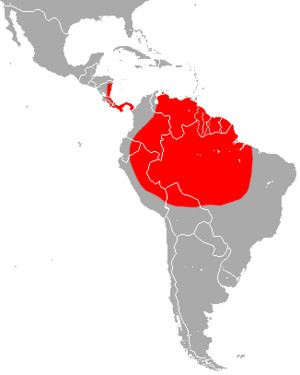Chestnut sac-winged bat facts for kids
Quick facts for kids Chestnut sac-winged bat |
|
|---|---|
 |
|
| Conservation status | |
| Scientific classification | |
| Genus: |
Cormura
|
| Species: |
brevirostris
|
 |
|
| Chestnut sac-winged bat range | |
The chestnut sac-winged bat, also known as Wagner's sac-winged bat, is a small bat found in South and Central America. Its scientific name is Cormura brevirostris. This bat is special because it's the only species in its group, called a genus.
About This Bat
The chestnut sac-winged bat is a small bat. Adults are usually about 7 cm (2.8 in) long. They weigh between 7 to 11 g (0.25 to 0.39 oz), which is about as much as a few paperclips.
Its body is covered in soft, thick fur. This fur is brown-black or red-brown. It's darker on its back and lighter on its belly. The fur also covers the inner parts of its wings. It reaches halfway down its upper arm bone (humerus) and halfway down its thigh bone (femur).
The bat's wings are black. The wing membranes stretch all the way to its ankles. Its tail is about 1.5 cm (0.59 in) long. It sticks out from the middle of the membrane between its legs. However, you can only see a tiny bit of the tail tip, about 1 to 3 mm (0.039 to 0.118 in), above this membrane.
Special Wing Sacs
Male chestnut sac-winged bats have unique sacs on their wings. These sacs are found in the middle of the front part of the wing membranes. They reach from the edge of the wing almost to the elbow. This is different from other sac-winged bats. In most other species, the sac is much closer to the bat's body.
Where They Live
Chestnut sac-winged bats live in many parts of Central and South America. In the south, you can find them in eastern Ecuador and Peru. They also live in northern Bolivia and as far east as central Brazil.
Further north, they are found all over Colombia, Venezuela, and the Guyanas. They also live throughout Central America, reaching eastern Nicaragua. There are no different types (subspecies) of this bat. They like to live in warm, wet forests that are not too high up.
How They Live
Chestnut sac-winged bats hunt for insects. They fly in open spaces and gaps just below the forest treetops. They are most active right after sunset and just before sunrise. During the day, they rest inside holes in trees or fallen logs.
These bats live in small groups. A group usually has up to five bats. Each group has only one female bat.
Echolocation
Chestnut sac-winged bats use echolocation to find their way and hunt. This means they send out sounds and listen for the echoes. Their calls have three short pulses. Each pulse is higher in pitch than the last. The sounds go from 25 to 32 kHz. This special sound helps them find flying insects from far away.
Breeding
In Panama, these bats have been seen breeding between April and May. However, they might breed at different times of the year in other places.


